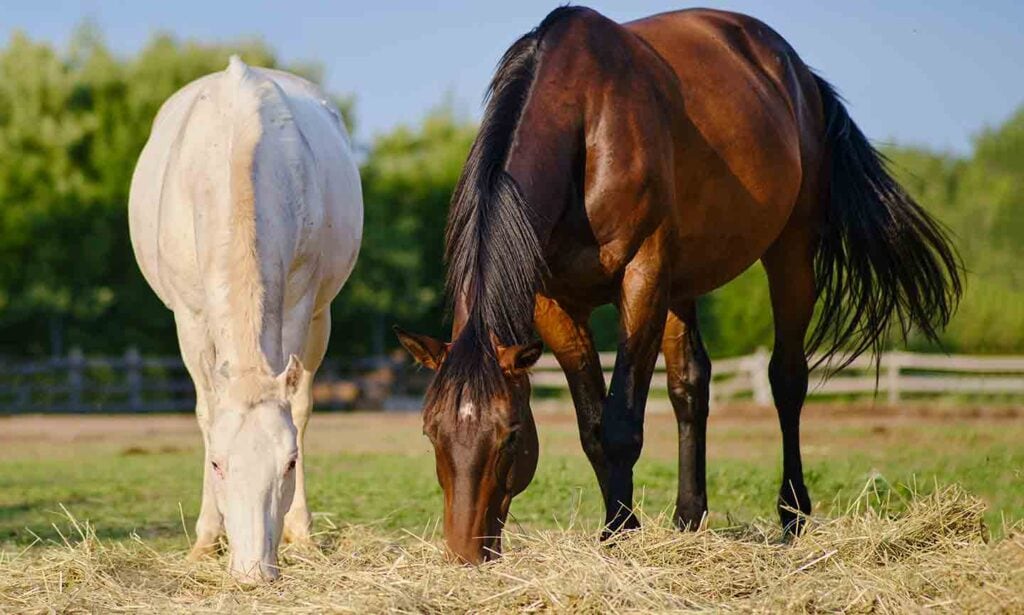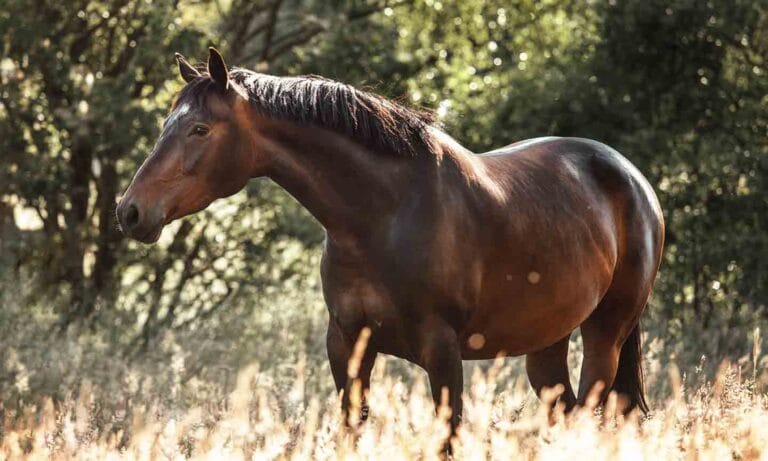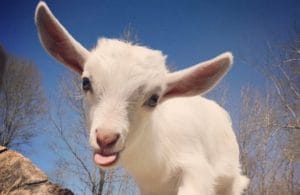Weighing over 1,000 pounds on average, horses are powerful creatures. Given their impressive stature and muscular builds, you may be surprised to learn that horses have relatively small stomachs. Due to their unique anatomy, horses are particularly susceptible to digestive issues like colic.
Colic, a term used to describe abdominal pain, was once a leading killer of horses. Improvements in diagnostics and treatment have led to much stronger prognoses, but colic is still common. Here’s what you need to know about this issue and how to help a horse with colic.
In This Guide
What is Colic in Horses?
The term “colic” refers to a symptom rather than a disease. According to the Merck Veterinary Manual, the strictest definition of the term is abdominal pain. However, colic has come to be used in a much broader sense: It is used in reference to over 70 conditions that cause abdominal pain in horses.
Colic frequently presents with signs of discomfort. Common clinical signs include:
- Pawing at the ground
- Looking back at the flank
- Arching the neck
- Curling the upper lip
In more severe cases, the horse may lie on their side or even roll violently from side to side, potentially injuring themselves in the process.
Types of Colic
Because colic is a symptom, not a disease, cases of equine colic can be classified in several ways. Some veterinarians divide colic cases by whether they require surgical versus medical treatment. Others categorize them more specifically.
Dr. Daizie Labelle, DVM, a veterinarian and the owner of Petaluma Equine in Petaluma, California, says the types of colic “are often differentiated based on the underlying factors contributing to the pain.”
Some of the most common types of colic in horses include:
- Gas colic
- Impaction colic
- Spasmodic colic
- Colon shift
- Enterolith colic
- Sand colic
- Parasitic colic
While the signs of colic reliably indicate that a horse is in pain, alone they may not be enough to tell which part of the gastrointestinal tract is involved. A thorough physical exam is required to identify the underlying issue and to tell whether surgery will be necessary.
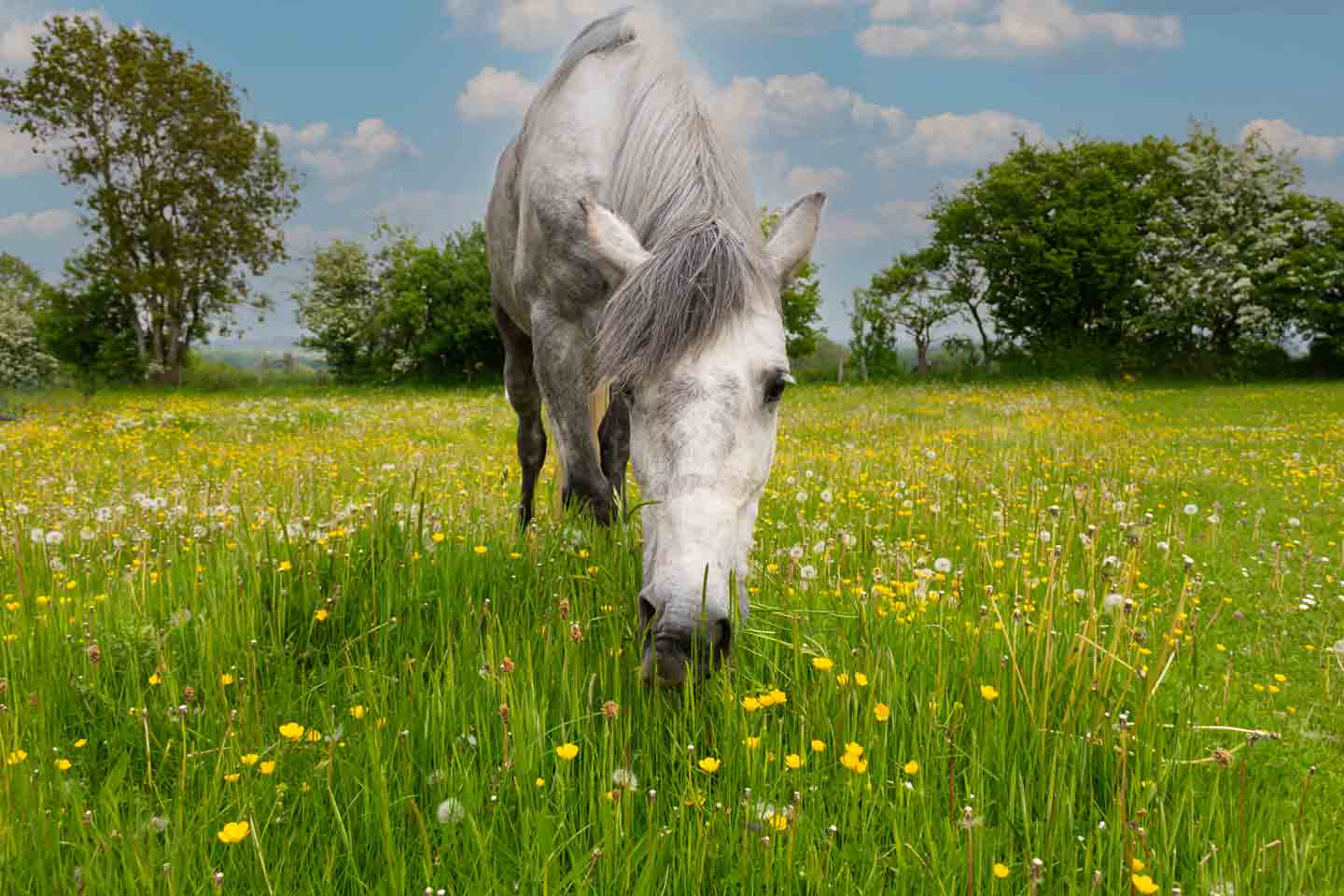
What Causes Colic in Horses?
Abdominal pain in horses is typically caused by gastrointestinal issues. Knowing the basics about the equine digestive tract is key to understanding colic in horses.
Horses are not strictly monogastric, or having a stomach with a single compartment, like dogs and humans. But neither are they ruminants like cows, whose stomachs have four compartments.
A horse’s stomach is surprisingly small, making up less than 10 percent of the capacity of the digestive system. Enzymes in the stomach and small intestine initiate the breakdown of food, but bacteria in the hindgut performs the bulk of digestion. The hindgut, or large intestine, consists of the cecum, large colon, small colon, rectum and anus.
Anything that disrupts this complex digestive process can lead to colic. The Merck Veterinary Manual suggests that, in most cases, colic develops for one of the following four reasons:
- Gas, fluid, or partially digested food stretching of the wall of the intestine
- Excessive tension on the membrane that holds the intestine in place
- Reduced or restricted blood flow to part of the digestive tract
- Inflammation of the wall of the intestine
While colic often directly relates to underlying gastrointestinal problems, digestive issues can be triggered or worsened by an array of factors. Something as simple as a sudden change in weather, Labelle says, “could influence how much a horse drinks, eats or exercises and increases their susceptibility to colic.”
Horses of any breed, sex or age can develop colic. However, some may be more likely to experience it.
“Younger horses may be more likely to develop colic due to intestinal parasites, or an older horse may be more susceptible to colic due to a mass causing strangulation and obstruction of the intestinal tract,” says Dr. Don LeHoullier, DVM, veterinarian and the owner of Countryside Veterinary Clinic in Jefferson, Oregon.
According to LeHoullier, risk factors that can lead to colic include the following:
- Sudden changes in diet
- Extreme weather
- Intestinal parasite infection
- Ingestion of sand
- Excessive body weight
- High-grain or low-forage diet
- Dental issues
- Decreased water intake or dehydration
- Chronic stress
LeHoullier also says long-term use of nonsteroidal anti-inflammatory drugs (NSAIDs) may increase a horse’s risk for colic.
Once they experience an episode of colic, horses may have an increased risk of recurrence. Early diagnosis and treatment, followed by proper care and preventive measures, can help you keep your horse healthy and happy.
Symptoms of Colic in Horses
Colic can come on suddenly. Because gastrointestinal issues are a common cause of colic, it’s essential to quickly identify symptoms and seek treatment. Failure to identify the symptoms of colic could mean a treatable condition progresses into a life-threatening issue.
Symptoms of colic in horses may include:
- Loss of appetite
- Restlessness
- Pawing at the ground
- Looking back at the flank
- Kicking at the abdomen
- Sweating
- Changes in gut motility
- Stretching as if to urinate
- Elevated heart rate
- Rapid breathing
- Frequent attempts to lie down
- Rolling or thrashing
- Lethargy
Unfortunately, it can be difficult to assess the severity of colic signs. The better you know your horse, the more easily you’ll be able to identify changes in behavior that might indicate a problem. Such changes, combined with objective clinical signs, can help you gauge the necessity for veterinary intervention.
What to Do if Your Suspect Your Horse Has Colic
If you suspect your horse has colic, close observation is a must. “If the horse is showing mild signs and is quiet,” LeHoullier says, “it’s OK to watch for an hour or two.” Withdraw feed but offer fresh water. Should the symptoms persist or worsen, consult your veterinarian.
While monitoring your horse’s condition, keep tabs on their vital signs. Look for elevations in heart rate, changes in gum color and indications of worsening pain. “If the signs persist through this time, get worse at any time or disappear and return,” says LeHoullier, “consult with your veterinarian.”
In mild cases of colic, Labelle says it’s OK to walk your horse if you can keep them safe. If your horse is trying to lie down, don’t try to prevent them. Labelle says it’s better to move the horse to “a safe place like a round pen or an arena where they can go down safely without getting cast against a stall wall.”
For moderate to severe cases, LeHoullier cautions against walking a colicky horse unless they’re trying to roll or thrash. The horse should not be made to walk, but in some cases walking can help prevent self-injurious behavior.
When to Call Your Veterinarian
When a horse has colic, the situation can change on a dime. If you’re debating whether to involve your vet, err on the side of caution. “It’s better to seek veterinary advice promptly rather than waiting,” Labelle says, “as delayed intervention can lead to more severe complications.”
Colic symptoms can range from mild to severe, and it can be an emergency. Labelle says immediate veterinary intervention may be required if your horse exhibits the following:
- Elevated heart rate
- Persistent pawing
- Sweating
- Rolling excessively
- Repeatedly lying down
- Absence of bowel movements
- Lack of interest in food
When you call your veterinarian, offer as much information as possible. Details about your horse’s recent exercise level, food intake and bowel activity are key for making an accurate diagnosis.
LeHoullier also recommends taking your horse’s rectal temperature and heart rate, if it’s safe to do so, before calling your veterinarian. Do not administer any medications before you talk to your vet.
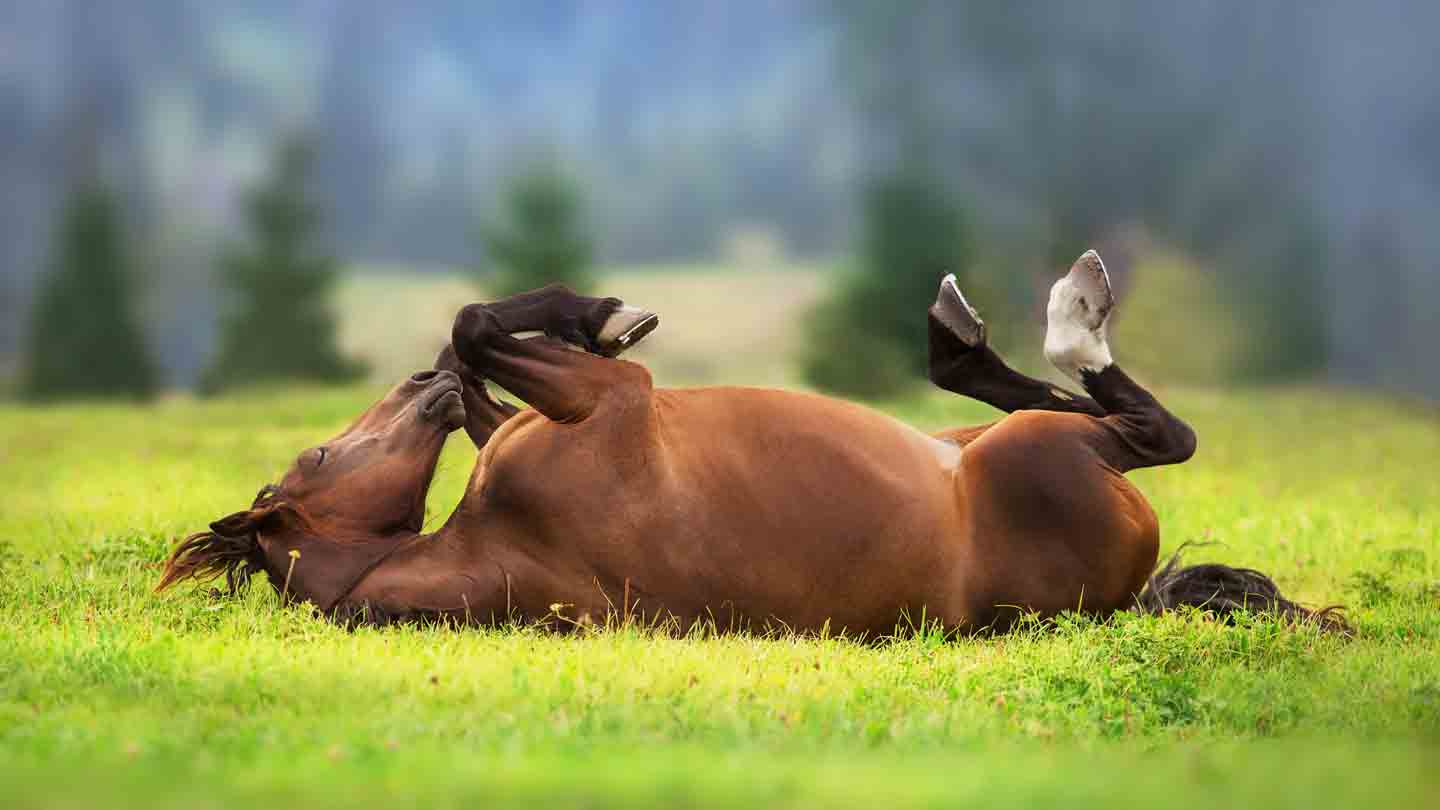
Treatment for Colic in Horses
The first step in treating colic is a thorough physical and rectal examination. While it may not be possible to identify the exact cause of colic through a rectal exam, your vet may be able to narrow down the options. An exam also gives your vet a chance to assess your horse’s cardiovascular status and look for signs of shock.
According to the Merck Veterinary Manual, almost all horses with colic require some form of medical treatment. Surgical treatment, however, is only necessary in the case of certain intestinal diseases.
In some cases, it may be best to treat the horse medically, then evaluate their response to treatment. Medical treatment for colicky horses is typically geared toward pain relief but may also involve intravenous fluid therapy; intestinal lubricants or laxatives; and deworming.
Let’s take a closer look at some common treatments for colic, and the situations in which they might be used.
Medications
Analgesic medications are a first-line treatment for colic. Labelle says most colics are treated with NSAIDs like Banamine, though additional pain relief may be needed in severe cases. Horses with spasmodic colic may also benefit from treatment with an antispasmodic drug like Buscopan, which helps suppress spasms of the digestive system.
Other medications used in colic treatment include sedatives to prevent dangerous behavior and drugs to prevent endotoxemia, which is when high levels of dangerous bacterial toxins are released into the horse’s bloodstream. When intestinal mucous membranes are damaged—such as through enteritis or intestinal ischemia—bacteria from the gut can enter the bloodstream and cause toxemia.
Nasogastric Tube
In cases of gas colic and reflux, veterinarians often place nasogastric tubes to help relieve pain from gastric distention. The tube is passed through the horse’s nostril into the stomach to relieve excessive gas or remove fluid. When colic is related to blockage of the small intestine, this treatment may help prevent stomach rupture from fluid buildup.
Fluid Therapy
Fluid therapy—administered intravenously or through a nasogastric tube—helps prevent dehydration during colic episodes. Laboratory tests are generally required to determine the right formulation to replenish electrolyte levels.
Lubricants and Laxatives
Impaction colic and sand colic can sometimes be remedied with a lubricant to ease the passage of the blockage. Mineral oil is commonly used to resolve minor impactions, but sand impactions and more severe colon obstructions may also require the use of a fecal-softening agent.
Surgery
Labelle says surgical treatment for colic is most often required when:
- There is a twist in the intestine (torsion or volvulus)
- There is an enterolith (accumulation of minerals, causing a blockage)
- The horse’s pain cannot be controlled
In rare cases, colic surgery is performed diagnostically when a horse has repeated episodes that don’t respond to conventional medical treatments.
Caring for Your Horse After Colic
Aftercare for a horse with colic looks different depending on the severity of the episode and its underlying cause. LeHoullier says post-treatment care may be “as simple as observation and NSAID administration for a few days,” or as complex as hospitalization and intensive post-operative care.
In all cases, it’s important for horse owners to follow their veterinarian’s advice regarding medications, and to monitor your horse for recurring symptoms or behavioral abnormalities. Veterinarians often recommend against feeding a colicky horse grain or hay until they pass manure. Fresh grass, in small amounts, might help stimulate gut motility.
Horses recovering from colic surgery may need to be initially confined to their stall. “These horses will have a prescribed rehab protocol to return to activity,” Labelle says.
How to Prevent Colic in Horses
Good management practices are key in reducing a horse’s risk of colic. Labelle says this includes:
- A consistent and balanced diet
- Regular access to clean water
- Proper parasite control
- Routine dental care
- A gradual introduction of changes to the horse’s routine
Any sudden changes to your horse’s routine have the potential to increase the incidence of colic. Always consult your veterinarian before making significant changes to your horse’s diet or exercise routine, and offer plenty of opportunities for mental stimulation to reduce stress.
More Help With Horses
Share:
